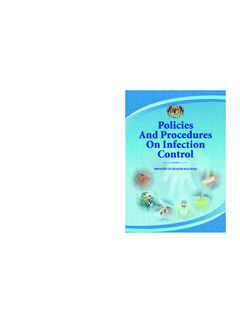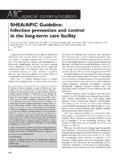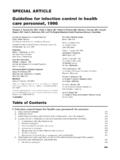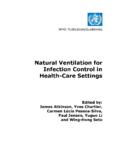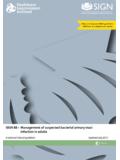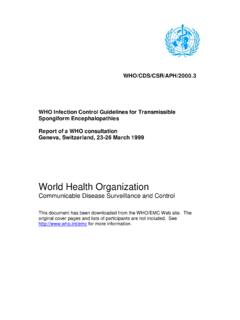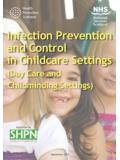Transcription of INFECTION CONTROL AND HOSPITAL …
1 Vol. 23 No. 12, Suppl. INFECTION CONTROL AND HOSPITAL epidemiology S3. GUIDELINE FOR HAND HYGIENE IN HEALTH-CARE. SETTINGS: RECOMMENDATIONS OF THE HEALTHCARE. INFECTION CONTROL PRACTICES ADVISORY. COMMITTEE AND THE HICPAC/SHEA/APIC/IDSA. HAND HYGIENE TASK FORCE. John M. Boyce, MD; Didier Pittet, MD. SUMMARY. The Guideline for Hand Hygiene in Health-Care Settings 1995;23:251 69) were issued and provides an in-depth review of provides health-care workers (HCWs) with a review of data hand-hygiene practices of HCWs, levels of adherence of personnel regarding handwashing and hand antisepsis in health-care set- to recommended handwashing practices, and factors adversely tings. In addition, it provides specific recommendations to promote affecting adherence. New studies of the in vivo efficacy of alcohol- improved hand-hygiene practices and reduce transmission of path- based hand rubs and the low incidence of dermatitis associated ogenic microorganisms to patients and personnel in health-care with their use are reviewed.
2 Recent studies demonstrating the settings. This report reviews studies published since the 1985 value of multidisciplinary hand-hygiene promotion programs and CDC guideline (Garner JS, Favero MS. CDC guideline for hand- the potential role of alcohol-based hand rubs in improving hand- washing and HOSPITAL environmental CONTROL , 1985. Infect CONTROL hygiene practices are summarized. Recommendations concerning 1986;7:231 43) and the 1995 APIC guideline (Larson EL, APIC related issues ( , the use of surgical hand antiseptics, hand guidelines Committee. APIC guideline for handwashing and hand lotions or creams, and wearing of artificial fingernails) are also antisepsis in health care settings. Am J Infect CONTROL included (Infect CONTROL Hosp Epidemiol 2002;23[suppl]:S3-S40). PART I. REVIEW OF THE consistently had a higher mortality rate than those whose SCIENTIFIC DATA REGARDING babies were delivered by midwives in the Second He HAND HYGIENE noted that physicians who went directly from the autopsy suite to the obstetrics ward had a disagreeable odor on their HISTORICAL PERSPECTIVE hands despite washing their hands with soap and water upon For generations, handwashing with soap and water entering the obstetrics clinic.)
3 He postulated that the puerper- has been considered a measure of personal The al fever that affected so many parturient women was caused concept of cleansing hands with an antiseptic agent proba- by cadaverous particles transmitted from the autopsy suite bly emerged in the early 19th century. As early as 1822, a to the obstetrics ward via the hands of students and physi- French pharmacist demonstrated that solutions containing cians. Perhaps because of the known deodorizing effect of chlorides of lime or soda could eradicate the foul odors chlorine compounds, as of May 1847, he insisted that stu- associated with human corpses and that such solutions dents and physicians clean their hands with a chlorine solu- could be used as disinfectants and In a paper tion between each patient in the clinic. The maternal mortal- published in 1825, this pharmacist stated that physicians ity rate in the First Clinic subsequently dropped dramatically and other persons attending patients with contagious dis- and remained low for years.
4 This intervention by eases would benefit from moistening their hands with a liq- Semmelweis represents the first evidence indicating that uid chloride cleansing heavily contaminated hands with an antiseptic In 1846, Ignaz Semmelweis observed that women agent between patient contacts may reduce health-care asso- whose babies were delivered by students and physicians in ciated transmission of contagious diseases more effectively the First Obstetrics Clinic at the General HOSPITAL of Vienna than handwashing with plain soap and water. Dr. Boyce is from the HOSPITAL of Saint Raphael, New Haven, Connecticut; and Dr. Pittet is from the University of Geneva, Geneva, Switzerland. The material in this report originated in the National Center for Infectious Diseases, James M. Hughes, MD, Director; and the Division of Healthcare Quality Promotion, Steve Solomon, MD, Acting Director.
5 This article is being published simultaneously in INFECTION CONTROL and HOSPITAL epidemiology and the American Journal of INFECTION CONTROL . It was also published in Morbidity and Mortality Weekly Report (2002;51[RR16]:1-44) and can be accessed at The Morbidity and Mortality Weekly Report version contains a continuing education examination. S4 INFECTION CONTROL AND HOSPITAL epidemiology December 2002. In 1843, Oliver Wendell Holmes concluded inde- NORMAL BACTERIAL SKIN FLORA. pendently that puerperal fever was spread by the hands To understand the objectives of different approaches of health Although he described measures to hand cleansing, a knowledge of normal bacterial skin flora that could be taken to limit its spread, his recommenda- is essential. Normal human skin is colonized with bacteria;. tions had little impact on obstetric practices at the time.
6 Different areas of the body have varied total aerobic bacteri- However, as a result of the seminal studies by al counts ( , 1 106 colony forming units (CFUs)/cm2 on Semmelweis and Holmes, handwashing gradually the scalp, 5 105 CFUs/cm2 in the axilla, 4 104 CFUs/cm2. became accepted as one of the most important measures on the abdomen, and 1 104 CFUs/cm2 on the forearm).13. for preventing transmission of pathogens in health-care Total bacterial counts on the hands of medical personnel facilities. have ranged from 104 to In 1938, bacte- In 1961, the Public Health Service produced a ria recovered from the hands were divided into two cate- training film that demonstrated handwashing techniques gories: transient and Transient flora, which colo- recommended for use by health-care workers (HCWs).4 At nize the superficial layers of the skin, are more amenable to the time, recommendations directed that personnel wash removal by routine handwashing.
7 They are often acquired their hands with soap and water for 1 2 minutes before and by HCWs during direct contact with patients or contact with after patient contact. Rinsing hands with an antiseptic agent contaminated environmental surfaces within close proximity was believed to be less effective than handwashing and was of the patient. Transient flora are the organisms most fre- recommended only in emergencies or in areas where sinks quently associated with health-care associated infections . were unavailable. Resident flora, which are attached to deeper layers of the In 1975 and 1985, formal written guidelines on hand- skin, are more resistant to removal. In addition, resident washing practices in hospitals were published by the flora ( , coagulase-negative staphylococci and diph- Centers for Disease CONTROL and Prevention (CDC).)
8 5,6 theroids) are less likely to be associated with such infec- These guidelines recommended handwashing with non- tions. The hands of HCWs may become persistently colo- antimicrobial soap between the majority of patient contacts nized with pathogenic flora ( , S. aureus), gram-negative and washing with antimicrobial soap before and after per- bacilli, or yeast. Investigators have documented that, forming invasive procedures or caring for patients at high although the number of transient and resident flora varies risk. Use of waterless antiseptic agents ( , alcohol-based considerably from person to person, it is often relatively con- solutions) was recommended only in situations where stant for any specific ,18. sinks were not available. In 1988 and 1995, guidelines for handwashing and PHYSIOLOGY OF NORMAL SKIN.
9 Hand antisepsis were published by the Association for The primary function of the skin is to reduce water Professionals in INFECTION CONTROL (APIC).7,8 Recommended loss, provide protection against abrasive action and indications for handwashing were similar to those listed in microorganisms, and act as a permeability barrier to the the CDC guidelines . The 1995 APIC guideline included environment. The basic structure of skin includes, from more detailed discussion of alcohol-based hand rubs and outer- to innermost layer, the superficial region ( , the supported their use in more clinical settings than had been stratum corneum or horny layer, which is 10- to 20- m recommended in earlier guidelines . In 1995 and 1996, the thick), the viable epidermis (50- to 100- m thick), the der- Healthcare INFECTION CONTROL Practices Advisory Com- mis (1- to 2-mm thick), and the hypodermis (1- to 2-mm mittee (HICPAC) recommended that either antimicrobial thick).
10 The barrier to percutaneous absorption lies within soap or a waterless antiseptic agent be used for cleaning the stratum corneum, the thinnest and smallest compart- hands upon leaving the rooms of patients with multidrug- ment of the skin. The stratum corneum contains the cor- resistant pathogens ( , vancomycin-resistant enterococci neocytes (or horny cells), which are flat, polyhedral-shaped [VRE] and methicillin-resistant Staphylococcus aureus nonnucleated cells, remnants of the terminally differentiat- [MRSA]).9,10 These guidelines also provided recommenda- ed keratinocytes located in the viable epidermis. tions for handwashing and hand antisepsis in other clinical Corneocytes are composed primarily of insoluble bundled settings, including routine patient care. Although the APIC keratins surrounded by a cell envelope stabilized by cross- and HICPAC guidelines have been adopted by the majority linked proteins and covalently bound lipid.


